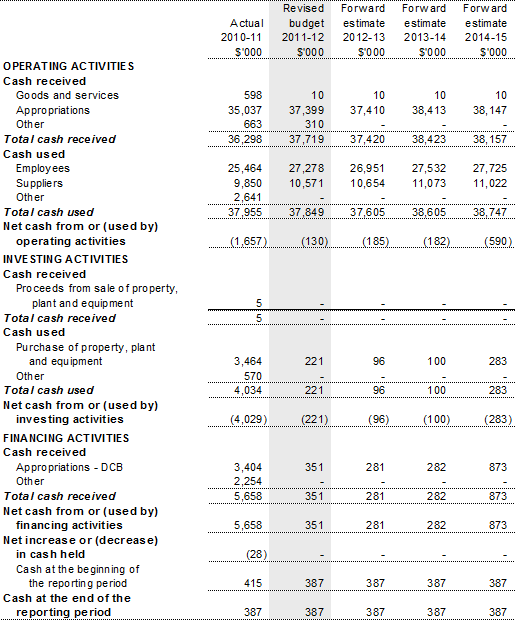Section 1: Agency overview and resources
1.1 Strategic direction
There has been no significant change to the strategic direction of the Productivity Commission from that outlined in the Portfolio Budget Statements 2011-12 (pages 325-326).
The Productivity Commission is seeking an additional $3.9 million in departmental outputs through Appropriation Bill (No. 3) 2011-12 for the Clean Energy Future – Governance – Productivity Commission Reviews measure as outlined in the Mid-Year Economic and Fiscal Outlook 2011-12 (page 288).
1.2 Agency resource statement
Table 1.1 shows the total resources from all origins. The table summarises how resources will be applied by outcome and departmental classification.
Table 1.1: Productivity Commission resource statement — additional estimates for
2011-12 as at Additional Estimates February 2012

1. Appropriation Bill (No. 3) 2011-12.
2. Includes $0.4 million in 2011-12 for the departmental capital budget (also refer Table 3.2.5).
1.3 Agency measures table
Table 1.2 summarises new Government measures taken since the 2011-12 Budget.
Table 1.2: Agency measures since Budget

1.4 Additional estimates and variations
Table 1.3 details the additional estimates and variations resulting from new measures since the 2011-12 Budget.
Table 1.3: Additional estimates and variations to outcomes from measures since
2010-11 Budget

Table 1.4: Additional estimates and variations to outcomes from other variations
The Productivity Commission does not have any other variations since the 2011-12 Budget that affect Appropriation Bills No. 3 and No. 4.
1.5 Breakdown of additional estimates by Appropriation Bill
Table 1.5 details the additional estimates sought for the Productivity Commission through Appropriation Bill No. 3. There are no additional estimates sought for the Productivity Commission through Appropriation Bill No. 4.
Table 1.5: Appropriation Bill (No. 3) 2011-12

Section 2: Revisions to agency outcomes and planned performance
2.1 Resources and performance information
There has been no change to outcomes or the outcome strategy for the Productivity Commission from that included in the Portfolio Budget Statements 2011-12 (page 328).
Table 2.1: Budgeted expenses and resources for Outcome 1

Program 1.1: Productivity Commission
There has been no change to the program objective, deliverables or key performance indicators from that included in the Portfolio Budget Statements 2011-12.
Table 2.2: Program expenses

Section 3: Explanatory tables and budgeted financial statements
3.1 Explanatory tables
3.1.1 Estimates of special account flows
There has been no change to special account flows that affect Appropriation Bills No. 3 and No. 4.
3.2 Budgeted financial statements
3.2.1 Analysis of budgeted financial statements
The Productivity Commission is budgeting for a departmental breakeven operating result for 2011-12 after adjusting for non-appropriated expenses of depreciation and amortisation.
The Productivity Commission has a sound financial position and currently has sufficient cash reserves to fund provisions and payables, and asset replacement, as they fall due.
3.2.2 Budgeted financial statements
Table 3.2.1: Budgeted departmental comprehensive income statement
(for the period ended 30 June)

Prepared on Australian Accounting Standards basis.
Table 3.2.2: Budgeted departmental balance sheet
(as at 30 June)

Prepared on Australian Accounting Standards basis.
Table 3.2.3: Budgeted departmental statement of cash flows
(for the period ended 30 June)

Prepared on Australian Accounting Standards basis.
Table 3.2.4: Departmental statement of changes in equity — summary of movement
(budget year 2011-12)

Prepared on Australian Accounting Standards basis.
Table 3.2.5: Departmental capital budget statement

Prepared on Australian Accounting Standards basis.
Table 3.2.6: Statement of asset movements — Departmental (2011-12)

Prepared on Australian Accounting Standards basis.
Notes to the financial statements
The Productivity Commission's budgeted statements are prepared on an accrual basis in accordance with:
- the Government's financial budgeting and reporting framework; and
- Australian Accounting Standards and Interpretations issued by the Australian Accounting Standards Board.
Departmental assets, liabilities, revenues and expenses are controlled by the department. Departmental expenses include employee and supplier expenses and other administrative costs, which are incurred by the department in providing goods and services.